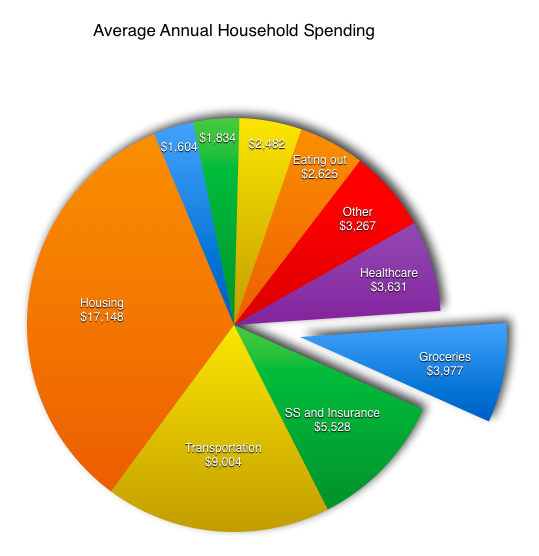Our modern way of life is often done unconsiously. We grow up doing certain actions and never question nor think of an alternate solution. What the GS Post will show in this and future articles is that green practices are also green for your bank account. Many of us face what seem to be constant expenses and a grapple with the beast of financial management. By incorporating smarter practices in our daily life, we will free ourselves from unnecessary waste while lining our pockets.
Smarter Grocery Shopping
It used to be pain at the pump. Now, it’s pain in the grocery aisle. Supermarket prices have been rising, and the average American household spends nearly $4,000 a year on groceries which amounts to $330 per month. Only housing, transportation, and insurance/Social Security cost more. For lower income families, 11% of their budget are for food and 6% for family incomes over $150,000.

American Annual Spending. Image courtesy of Fool.com
How you prepare your food will determine how shop for food. First, cut down on fast food, restaurants, and take-out. Going to McDonald’s three times a week costs as much as buying all the fruits and vegetables you need for the week. If you can garden, you can save money on buying vegetables which also taste better to boot!
When you are at the store, you can to get everything at as low of a per-unit cost as possible. This is where bulk purchasing comes in handy. There are many things we get like soap, shampoo, and rice that we buy consistently, but they also have a long shelf life. By buying these in bulk, they are cheaper and it saves you the time of worrying about getting more in the future. Not all bulk purchases are wise though. Perishable items like breads and produce will go bad in a few days, so it does not make sense to buy a large quantity of something for long-term if it’s a short-term item. Likewise, you can buy cookies in bulk, but do you really want to give yourself endless opportunity to get sweets?
Cooking Up Savings
It is possible to cook and save time. Let’s face it we all are lazy when we are hungry. That is why fast food is appealing. We get instant gratification, but we don’t realize this gratification actually takes time. If you drive to a fast-food outlet, wait in line, and come home, chances are you’ll spend 20 minutes to a half hour. That time could have been spent putting something together at the house, and you would have used no gas and put no wear and tear on your car.
First, try using scratch cooking which uses base ingredidents to cook something up. Prepared and frozen foods at the grocery store costs more because it factors in the labor cost of preparation, energy used, marketing costs, etc. Whereas you can buy flour and make bread, cake, pasta, cupcakes, pot pies, and of course apple crisp.

Apple Crisp. Image courtesy of SimplyScratch.com
Wait, wait, wait! This sounds like a lot of work. I have to cook from scratch? This is where time management is crucial and can nearly automate your cooking. Set aside a time of the week for a cook-a-thon. The idea is to make at least all of your breakfast, lunch, and snacks early. If you’re ambitious, you can also do breads, desserts, and dinner entrees. What I find when cooking is that once I get started it’s a lot easier to keep going. Not only that but it is also easier to make more food simulataneoulsly. By making all this in advance, you can create fast food at home where you just reach into the fridge and get you meal right then and there. All you would have to do is warm it up and maybe cook a quick egg.
Stop Drinking & Tossing
Nearly all of our drinks are packaged in cans and bottles. All of these go right to the trash when we are done. While recycling is a good idea, it’s always better to just conserve first by not using it. If you drink a lot of tea or soda, consider homebrewing your team or using a home soda machine like SodaStream. You will save on buying those cases of soda and gallons of tea. You can store them in glass containers which removes waste from plastic jugs and metal cans. The same philsophy can be applied to beer and wine. There are numerous resources to brew your own beer online, and it’s become a popular hobby for many.

Homebrew Beer. Image Courtesy of HomeBrewersAssociaton.org
Many Americans travel around with water bottles, but bottled water is expensive amounting to nearly $2 for something you can get out of your faucet. The key to that refreshing flavor is to filter out the metals and contaminants that give it a metallic taste. Remember that minerals do get lost in the filtration process, so some choose something to remineralize the water if you want the full nutritional value. A 1 lb. bag of Himalyan salt can do the job, and it just requires 1/4 of a teaspoon per gallon of water.
When you’re traveling with water or other cold liquids, use a stainless steel double-wall vacuum bottle. Stainless steel is safe for consumption, and the double-wall provides extra insulation to keep your drink cold.
By following these steps, we already can cut unnecessary expenses like fast food, prepared & processed food, a lot of food packaging, plastic jugs, plastic bottles, and metal cans from your life. As you can see, it’s just adding small changes to your daily routine that can save in the long run.
